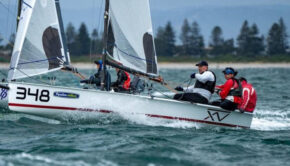The Science of Hiking
Published on March 27th, 2017
If you thought dinghy hiking was physically painful, this explanation regarding the science of hiking by Hamilton Sport may explode your brain.
Hiking is perhaps one of the most miserable sensations in sailing. It is absolutely necessary to hike in order to maintain good boat speed. The trade off is that to achieve decent boat speed you must endure a lot of pain.
Over the years I have heard many explanations for this excruciating burning sensation in the legs. I have also heard many training methods to improve hiking endurance. Scattered throughout all this, there have been many inaccurate explanations and absurd suggestions on how to deal with hiking. Hopefully this article will clear up some confusion and give an insight into how our body deals with hiking.
Hiking involves several major muscle groups. Quadriceps, glutes, spinae erectors and abdominal muscles are all heavily involved. We often refer to hiking as an isometric contraction. This is a little inaccurate.
Isometric contraction involves an application of force through the contraction of a muscle which is at a fixed length. In actual fact there are gradual and slight changes to the length of the muscles during hiking making it more quasi-isometric in nature. The process of fatigue however, remains the same.
When we contract our muscles the blood vessels are squeezed and blood flow is restricted. During dynamic contractions there is a relaxation phase during which the blood vessels are released again. This contraction relaxation process actually promotes bloodflow. This is absent in the case of hiking as we rarely have a full relaxation phase.
The restriction of bloodflow forces our muscles to generate energy for contraction through anaerobic means as oxygen is in short supply. The primary anaerobic energy system is called glycolysis. The major by-product of this is lactate.
Normally muscle is activated from its low fatigue, low power type to high fatigue, high power types. These are known as type one and type two muscle fibres. Each fibre type is reliant on a different energy system; type one Oxidative and type two glycolytic. In the absence of oxygen, type two fibres must become active.
Normally as type one muscle fibres fatigue, type two begin to activate and take over some of the work. During hiking we don’t really have that option as most type 2 fibres activate very early. Fatigue of this type can be witnessed by assessing surface electrical signals in the muscles by Electromyograpic (EMG) analysis.
The image below shows EMG during a hiking endurance test. EMG activity increase as more muscle fibres are activated to maintain power output.
There are several reasons why these muscle fibres fatigue. Firstly, the production and accumulation of lactate can interfere with muscle contractions. Secondly, there must be an adequate supply of energy substrate ie. glucose or glycogen. Thirdly, repeated high intensity contractions damage muscle cells causing a leakage and reduced chemical gradients essential for efficient contraction. These combine to cause a reduction in sustainable force output.
The question now is how to manage this. Generally speaking, larger cross-sectional muscle areas generate larger isometric force. So bigger stronger muscles will cope with loads much more efficiently. Adequate strength training is essential in order to cope with the forces required for hiking. In addition to this, we must improve our ability to deliver oxygen and promote bloodflow to the working muscle.
Capillarization of the muscle occurs when it is subjected to long durations under mildly ischemic conditions. For most of us we achieve this through cycling. The problem is that this process occurs over a long period of time and is quite gradual. That is why there is a need to complete many long duration cycling sessions in the offseason. It cannot be accomplished during a short training camp.
Improving the aerobic system also helps us to remove lactate and reduce the effects it has on muscle contraction. The main issue with large volumes of aerobic type training is that it induces an adaptation which is not favorable to muscle growth or strength improvement.
It is essential to find a balance between the two. If we rely too heavily on aerobic conditioning we inhibit strength. The stronger we are, the relatively easier hiking becomes. If we do not have a good strength base then we will struggle even if we are well conditioned.
In addition to land based training, we can have a big influence by actually going sailing. While the physiological adaptations to sailing are probably a little more modest, we can gain a huge amount of technical advantages. Learning to shift tension on and off the muscle can help prolong endurance. Holding more efficient energy saving postures can also buy us time in relation to fatigue. Our tolerance for hiking is also improved.
The more we train and become accustomed to certain processes, the better we cope. Inhibitory sensors within the muscle can be somewhat overridden with training. In short, hiking more allows us to manage the fatigue more effectively.
Hiking is a pretty complex process. The biggest mistake is to assume that it is purely a reflection of aerobic conditioning. While aerobic conditioning will help endurance, strength and experience also have an enormous influence. The stronger the knee extensors, the easier hiking becomes and the less reliant we are on conditioning.
Do not neglect strength work and likewise do not neglect aerobic training. They are both essential to hiking endurance. Travelling and lack of facilities can be detrimental to progress and maintenance of endurance. One should make sure that organized and consistent training is maintained throughout the season.











 We’ll keep your information safe.
We’ll keep your information safe.